Taxation Report: Taxation Implications of Capital Gains and Deductions
VerifiedAdded on 2019/11/26
|12
|2651
|161
Report
AI Summary
This report provides a comprehensive analysis of taxation principles, focusing on capital gains, deductions, and assessable income under the Income Tax Assessment Act 1997 (ITAA 1997). The report begins by explaining the concept of capital gains and losses, outlining how they are calculated and included in assessable income as statutory income. It then delves into the deductibility of expenses, differentiating between general and specific deductions, and highlighting the treatment of capital expenditures. The report applies these principles to three case studies: the capital gain tax consequences for Cassandra Pty Ltd, the deductibility of expenses for Oscar Pty Ltd, and the treatment of unpaid installments for Earnest Construction Pty Ltd. It includes detailed calculations and explanations to illustrate the tax implications of each scenario, providing practical insights into the application of tax laws in various business contexts. The report concludes by emphasizing the importance of accurate income assessment and the correct treatment of capital gains, deductions, and bad debts to determine taxable income.
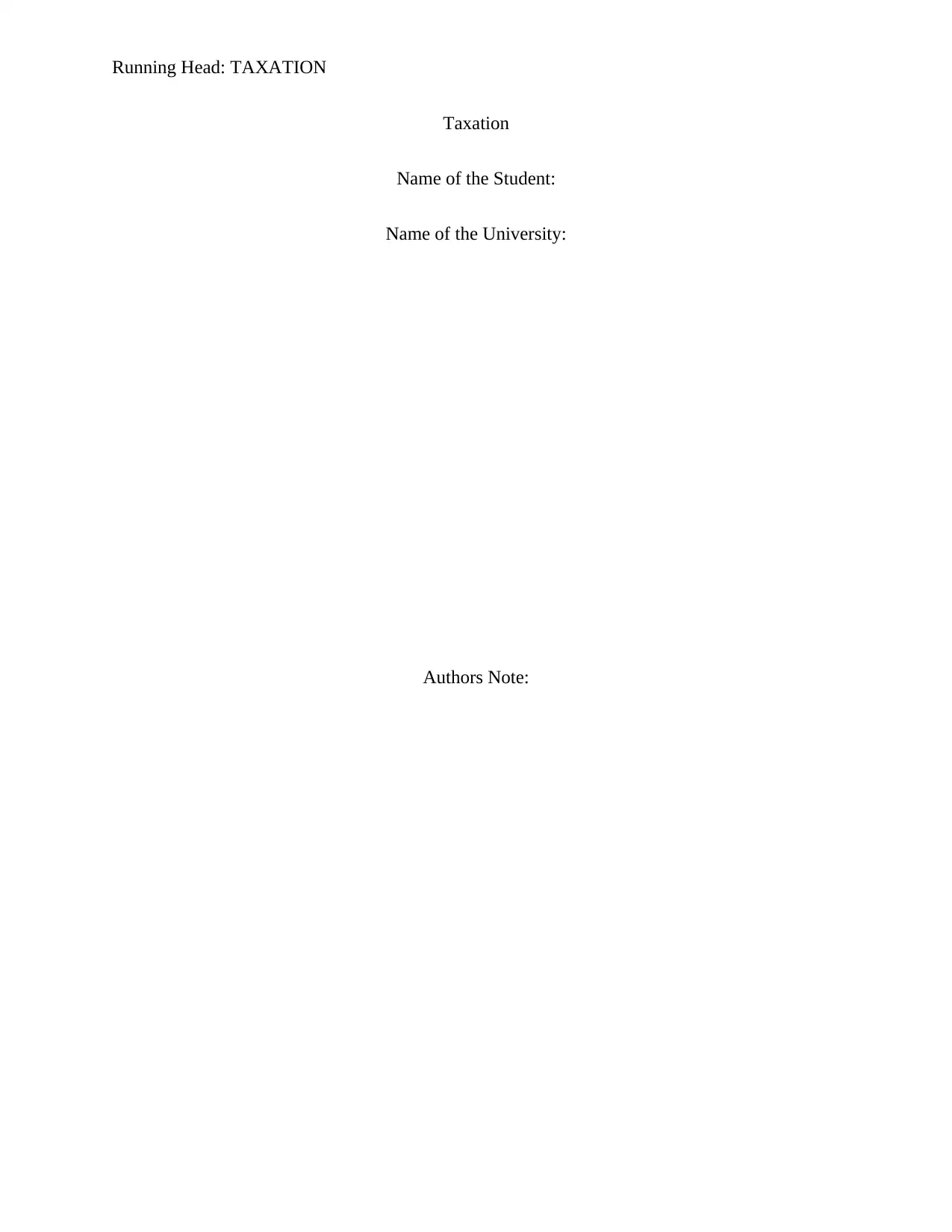
Running Head: TAXATION
Taxation
Name of the Student:
Name of the University:
Authors Note:
Taxation
Name of the Student:
Name of the University:
Authors Note:
Paraphrase This Document
Need a fresh take? Get an instant paraphrase of this document with our AI Paraphraser
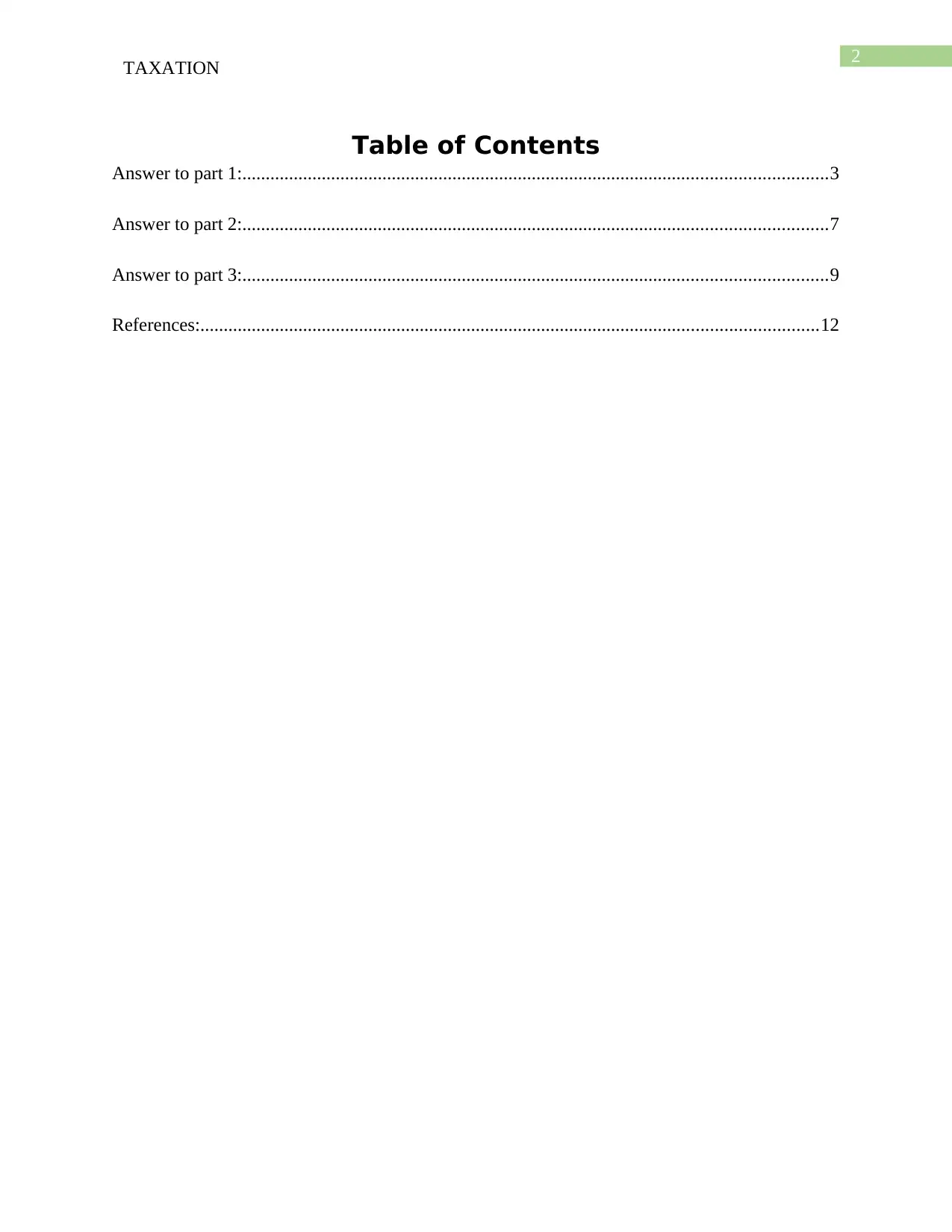
2
TAXATION
Table of Contents
Answer to part 1:.............................................................................................................................3
Answer to part 2:.............................................................................................................................7
Answer to part 3:.............................................................................................................................9
References:....................................................................................................................................12
TAXATION
Table of Contents
Answer to part 1:.............................................................................................................................3
Answer to part 2:.............................................................................................................................7
Answer to part 3:.............................................................................................................................9
References:....................................................................................................................................12
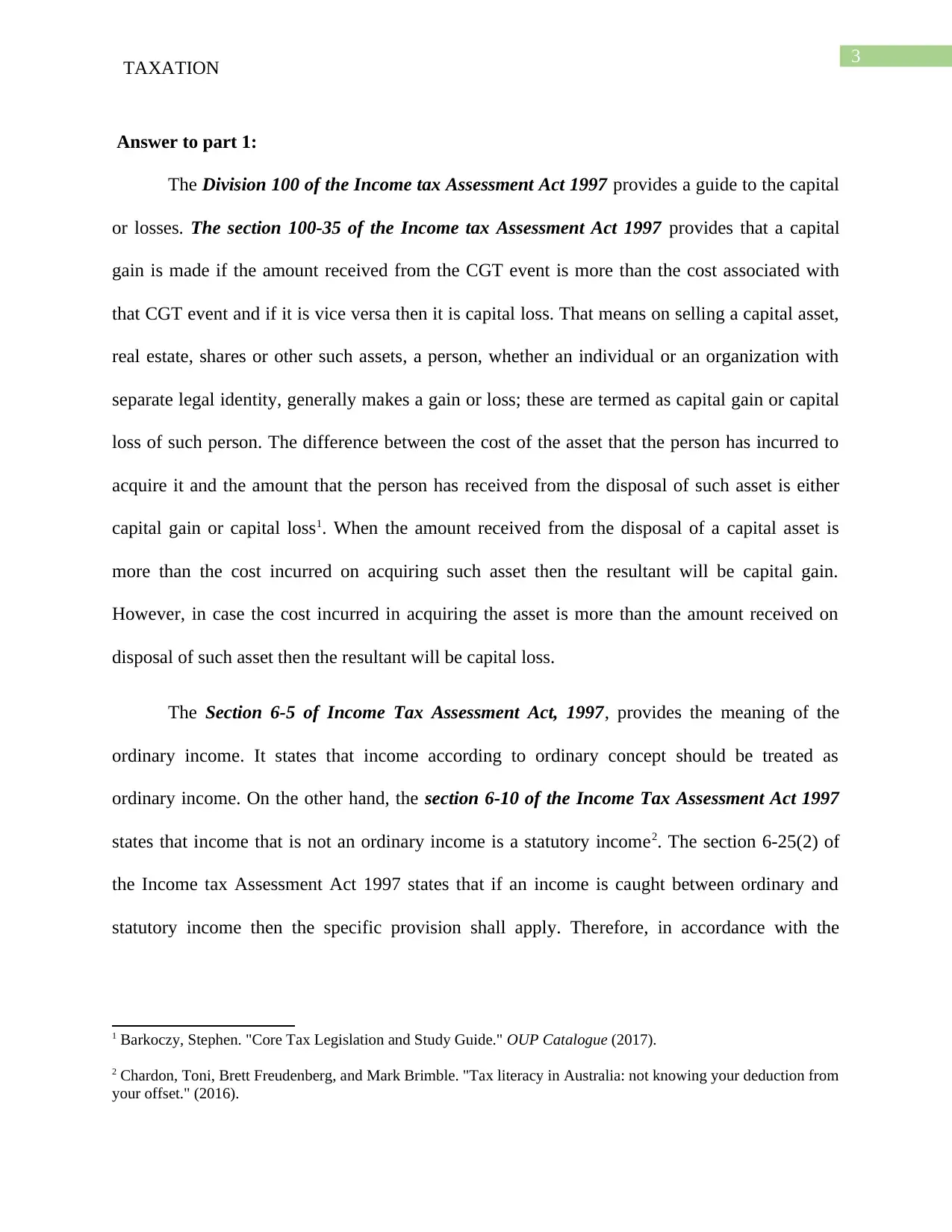
3
TAXATION
Answer to part 1:
The Division 100 of the Income tax Assessment Act 1997 provides a guide to the capital
or losses. The section 100-35 of the Income tax Assessment Act 1997 provides that a capital
gain is made if the amount received from the CGT event is more than the cost associated with
that CGT event and if it is vice versa then it is capital loss. That means on selling a capital asset,
real estate, shares or other such assets, a person, whether an individual or an organization with
separate legal identity, generally makes a gain or loss; these are termed as capital gain or capital
loss of such person. The difference between the cost of the asset that the person has incurred to
acquire it and the amount that the person has received from the disposal of such asset is either
capital gain or capital loss1. When the amount received from the disposal of a capital asset is
more than the cost incurred on acquiring such asset then the resultant will be capital gain.
However, in case the cost incurred in acquiring the asset is more than the amount received on
disposal of such asset then the resultant will be capital loss.
The Section 6-5 of Income Tax Assessment Act, 1997, provides the meaning of the
ordinary income. It states that income according to ordinary concept should be treated as
ordinary income. On the other hand, the section 6-10 of the Income Tax Assessment Act 1997
states that income that is not an ordinary income is a statutory income2. The section 6-25(2) of
the Income tax Assessment Act 1997 states that if an income is caught between ordinary and
statutory income then the specific provision shall apply. Therefore, in accordance with the
1 Barkoczy, Stephen. "Core Tax Legislation and Study Guide." OUP Catalogue (2017).
2 Chardon, Toni, Brett Freudenberg, and Mark Brimble. "Tax literacy in Australia: not knowing your deduction from
your offset." (2016).
TAXATION
Answer to part 1:
The Division 100 of the Income tax Assessment Act 1997 provides a guide to the capital
or losses. The section 100-35 of the Income tax Assessment Act 1997 provides that a capital
gain is made if the amount received from the CGT event is more than the cost associated with
that CGT event and if it is vice versa then it is capital loss. That means on selling a capital asset,
real estate, shares or other such assets, a person, whether an individual or an organization with
separate legal identity, generally makes a gain or loss; these are termed as capital gain or capital
loss of such person. The difference between the cost of the asset that the person has incurred to
acquire it and the amount that the person has received from the disposal of such asset is either
capital gain or capital loss1. When the amount received from the disposal of a capital asset is
more than the cost incurred on acquiring such asset then the resultant will be capital gain.
However, in case the cost incurred in acquiring the asset is more than the amount received on
disposal of such asset then the resultant will be capital loss.
The Section 6-5 of Income Tax Assessment Act, 1997, provides the meaning of the
ordinary income. It states that income according to ordinary concept should be treated as
ordinary income. On the other hand, the section 6-10 of the Income Tax Assessment Act 1997
states that income that is not an ordinary income is a statutory income2. The section 6-25(2) of
the Income tax Assessment Act 1997 states that if an income is caught between ordinary and
statutory income then the specific provision shall apply. Therefore, in accordance with the
1 Barkoczy, Stephen. "Core Tax Legislation and Study Guide." OUP Catalogue (2017).
2 Chardon, Toni, Brett Freudenberg, and Mark Brimble. "Tax literacy in Australia: not knowing your deduction from
your offset." (2016).
⊘ This is a preview!⊘
Do you want full access?
Subscribe today to unlock all pages.

Trusted by 1+ million students worldwide

4
TAXATION
section 102-5 of the Income tax Assessment Act 1997 it can be said that the capital gain should
be included in the assessable income as statutory income.
The Section 25-10 of ITAA provides that one can deduct expenditures incurred on repair
and maintenance on a depreciating asset only if such asset has sole been used to generate or to
produce assessable income. Thus, in case the sole purpose of the depreciating asset includes
anything else apart from using it for generation and production of assessable income then the
whole expenditures incurred on repair and maintenance of the asset would not be allowed as
deduction for computation of assessable income of the taxpayer concern3. According to sub-
section, 2 of this section (25-10 of ITAA) in case the property was party used for income
generation and party used for other purposes then proportionate amount of such expenditures
shall be allowed as deduction for computation of such assessable income. No capital expenditure
shall be allowed as deduction in computation of assessable income provided in sub section 3 of
section 25-10 of ITAA.
In determining the capital gain the concept of first element costs has to be worked out in
relation to a depreciating asset in accordance with the provision of section 40-180 of ITAA.
According to the provision of this section the first element is,
(a) The amount specified in an item; or
(b) The amount that has been paid by the existing owner to hold the asset4.
3 Mintrom, Michael, and Joannah Luetjens. "Design Thinking in Policymaking Processes: Opportunities and
Challenges." Australian Journal of Public Administration 75, no. 3 (2016): 391-402.
4 Kellow, Aynsley, and Marian Simms. "Policy change and industry associability: The Australian mining
sector." Australian Journal of Public Administration 72, no. 1 (2013): 41-54.
TAXATION
section 102-5 of the Income tax Assessment Act 1997 it can be said that the capital gain should
be included in the assessable income as statutory income.
The Section 25-10 of ITAA provides that one can deduct expenditures incurred on repair
and maintenance on a depreciating asset only if such asset has sole been used to generate or to
produce assessable income. Thus, in case the sole purpose of the depreciating asset includes
anything else apart from using it for generation and production of assessable income then the
whole expenditures incurred on repair and maintenance of the asset would not be allowed as
deduction for computation of assessable income of the taxpayer concern3. According to sub-
section, 2 of this section (25-10 of ITAA) in case the property was party used for income
generation and party used for other purposes then proportionate amount of such expenditures
shall be allowed as deduction for computation of such assessable income. No capital expenditure
shall be allowed as deduction in computation of assessable income provided in sub section 3 of
section 25-10 of ITAA.
In determining the capital gain the concept of first element costs has to be worked out in
relation to a depreciating asset in accordance with the provision of section 40-180 of ITAA.
According to the provision of this section the first element is,
(a) The amount specified in an item; or
(b) The amount that has been paid by the existing owner to hold the asset4.
3 Mintrom, Michael, and Joannah Luetjens. "Design Thinking in Policymaking Processes: Opportunities and
Challenges." Australian Journal of Public Administration 75, no. 3 (2016): 391-402.
4 Kellow, Aynsley, and Marian Simms. "Policy change and industry associability: The Australian mining
sector." Australian Journal of Public Administration 72, no. 1 (2013): 41-54.
Paraphrase This Document
Need a fresh take? Get an instant paraphrase of this document with our AI Paraphraser
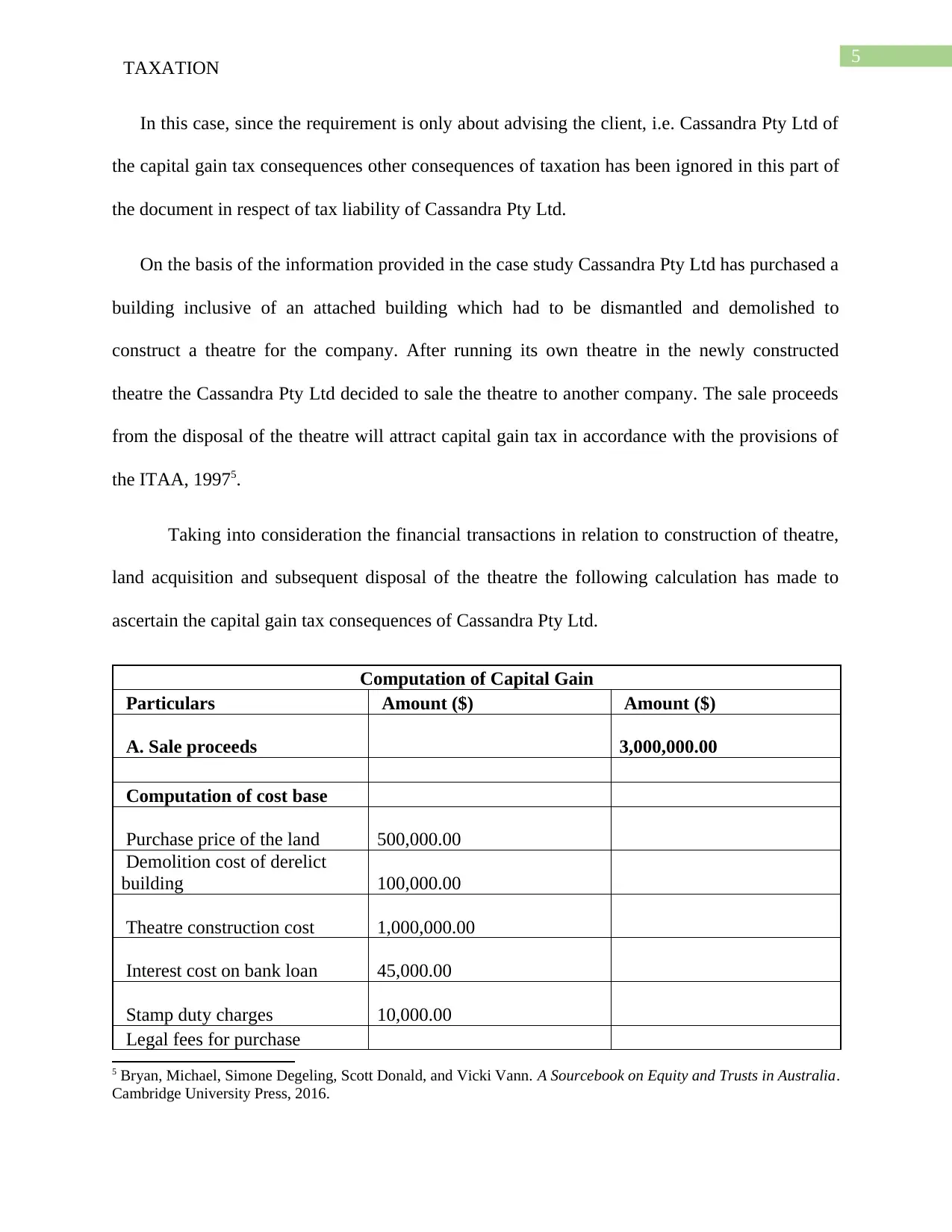
5
TAXATION
In this case, since the requirement is only about advising the client, i.e. Cassandra Pty Ltd of
the capital gain tax consequences other consequences of taxation has been ignored in this part of
the document in respect of tax liability of Cassandra Pty Ltd.
On the basis of the information provided in the case study Cassandra Pty Ltd has purchased a
building inclusive of an attached building which had to be dismantled and demolished to
construct a theatre for the company. After running its own theatre in the newly constructed
theatre the Cassandra Pty Ltd decided to sale the theatre to another company. The sale proceeds
from the disposal of the theatre will attract capital gain tax in accordance with the provisions of
the ITAA, 19975.
Taking into consideration the financial transactions in relation to construction of theatre,
land acquisition and subsequent disposal of the theatre the following calculation has made to
ascertain the capital gain tax consequences of Cassandra Pty Ltd.
Computation of Capital Gain
Particulars Amount ($) Amount ($)
A. Sale proceeds 3,000,000.00
Computation of cost base
Purchase price of the land 500,000.00
Demolition cost of derelict
building 100,000.00
Theatre construction cost 1,000,000.00
Interest cost on bank loan 45,000.00
Stamp duty charges 10,000.00
Legal fees for purchase
5 Bryan, Michael, Simone Degeling, Scott Donald, and Vicki Vann. A Sourcebook on Equity and Trusts in Australia.
Cambridge University Press, 2016.
TAXATION
In this case, since the requirement is only about advising the client, i.e. Cassandra Pty Ltd of
the capital gain tax consequences other consequences of taxation has been ignored in this part of
the document in respect of tax liability of Cassandra Pty Ltd.
On the basis of the information provided in the case study Cassandra Pty Ltd has purchased a
building inclusive of an attached building which had to be dismantled and demolished to
construct a theatre for the company. After running its own theatre in the newly constructed
theatre the Cassandra Pty Ltd decided to sale the theatre to another company. The sale proceeds
from the disposal of the theatre will attract capital gain tax in accordance with the provisions of
the ITAA, 19975.
Taking into consideration the financial transactions in relation to construction of theatre,
land acquisition and subsequent disposal of the theatre the following calculation has made to
ascertain the capital gain tax consequences of Cassandra Pty Ltd.
Computation of Capital Gain
Particulars Amount ($) Amount ($)
A. Sale proceeds 3,000,000.00
Computation of cost base
Purchase price of the land 500,000.00
Demolition cost of derelict
building 100,000.00
Theatre construction cost 1,000,000.00
Interest cost on bank loan 45,000.00
Stamp duty charges 10,000.00
Legal fees for purchase
5 Bryan, Michael, Simone Degeling, Scott Donald, and Vicki Vann. A Sourcebook on Equity and Trusts in Australia.
Cambridge University Press, 2016.
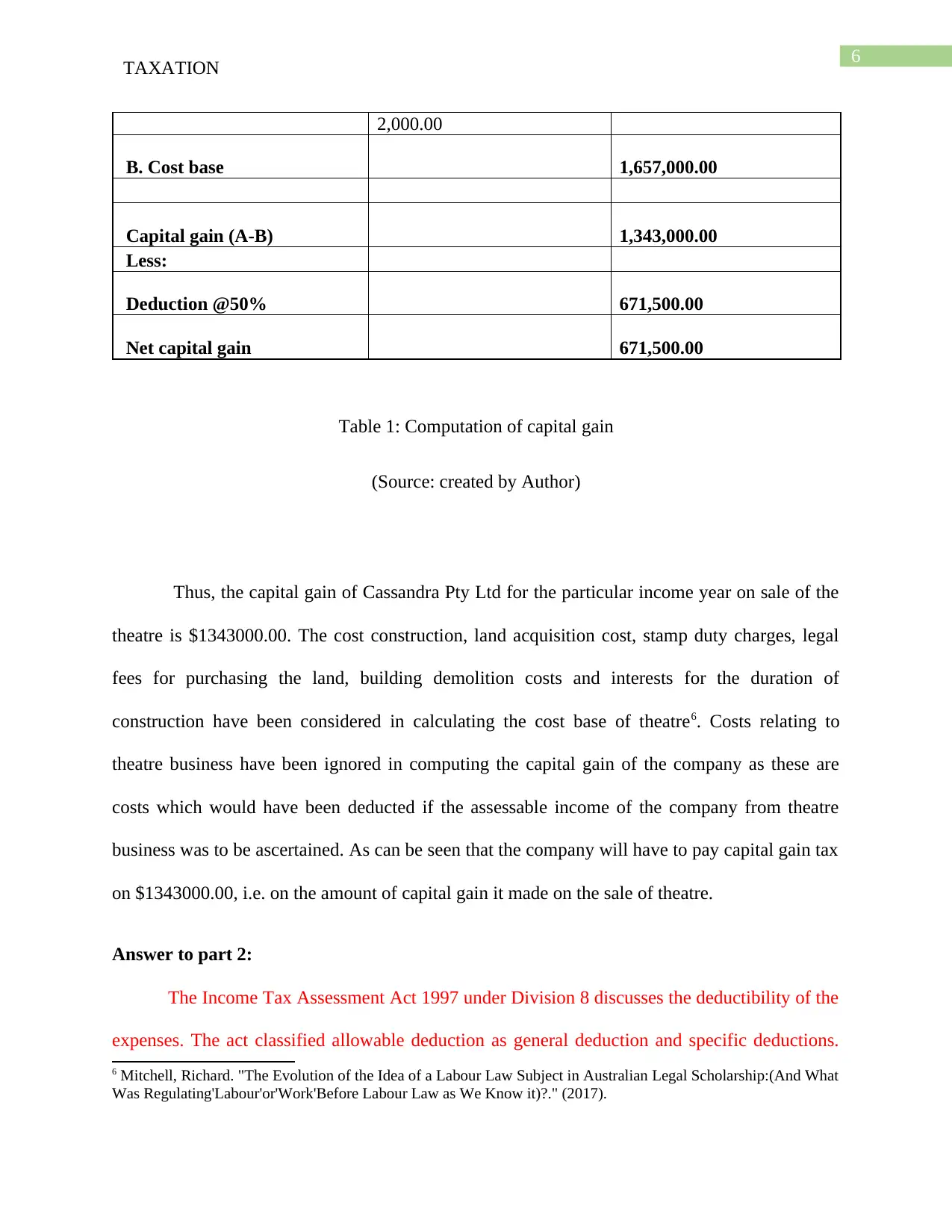
6
TAXATION
2,000.00
B. Cost base 1,657,000.00
Capital gain (A-B) 1,343,000.00
Less:
Deduction @50% 671,500.00
Net capital gain 671,500.00
Table 1: Computation of capital gain
(Source: created by Author)
Thus, the capital gain of Cassandra Pty Ltd for the particular income year on sale of the
theatre is $1343000.00. The cost construction, land acquisition cost, stamp duty charges, legal
fees for purchasing the land, building demolition costs and interests for the duration of
construction have been considered in calculating the cost base of theatre6. Costs relating to
theatre business have been ignored in computing the capital gain of the company as these are
costs which would have been deducted if the assessable income of the company from theatre
business was to be ascertained. As can be seen that the company will have to pay capital gain tax
on $1343000.00, i.e. on the amount of capital gain it made on the sale of theatre.
Answer to part 2:
The Income Tax Assessment Act 1997 under Division 8 discusses the deductibility of the
expenses. The act classified allowable deduction as general deduction and specific deductions.
6 Mitchell, Richard. "The Evolution of the Idea of a Labour Law Subject in Australian Legal Scholarship:(And What
Was Regulating'Labour'or'Work'Before Labour Law as We Know it)?." (2017).
TAXATION
2,000.00
B. Cost base 1,657,000.00
Capital gain (A-B) 1,343,000.00
Less:
Deduction @50% 671,500.00
Net capital gain 671,500.00
Table 1: Computation of capital gain
(Source: created by Author)
Thus, the capital gain of Cassandra Pty Ltd for the particular income year on sale of the
theatre is $1343000.00. The cost construction, land acquisition cost, stamp duty charges, legal
fees for purchasing the land, building demolition costs and interests for the duration of
construction have been considered in calculating the cost base of theatre6. Costs relating to
theatre business have been ignored in computing the capital gain of the company as these are
costs which would have been deducted if the assessable income of the company from theatre
business was to be ascertained. As can be seen that the company will have to pay capital gain tax
on $1343000.00, i.e. on the amount of capital gain it made on the sale of theatre.
Answer to part 2:
The Income Tax Assessment Act 1997 under Division 8 discusses the deductibility of the
expenses. The act classified allowable deduction as general deduction and specific deductions.
6 Mitchell, Richard. "The Evolution of the Idea of a Labour Law Subject in Australian Legal Scholarship:(And What
Was Regulating'Labour'or'Work'Before Labour Law as We Know it)?." (2017).
⊘ This is a preview!⊘
Do you want full access?
Subscribe today to unlock all pages.

Trusted by 1+ million students worldwide
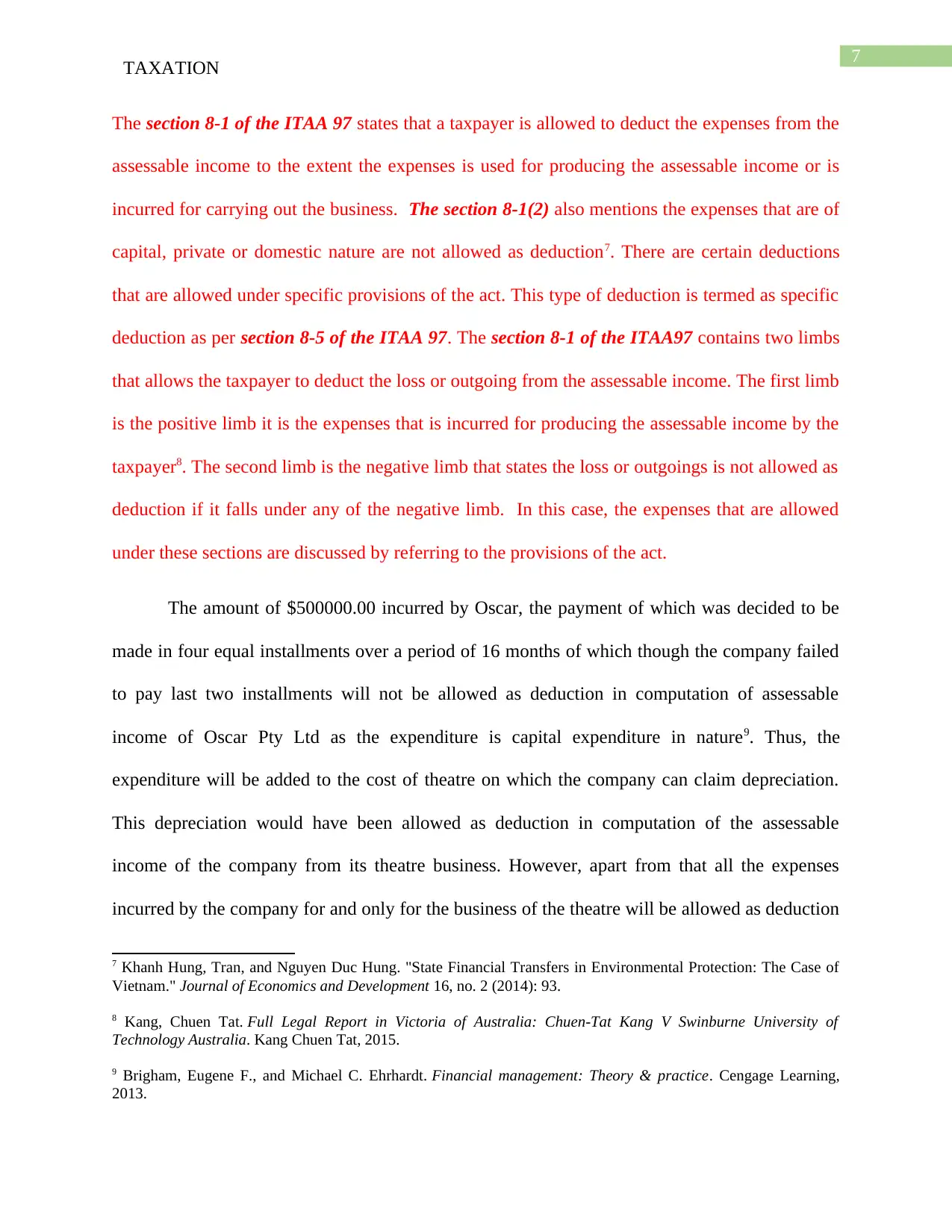
7
TAXATION
The section 8-1 of the ITAA 97 states that a taxpayer is allowed to deduct the expenses from the
assessable income to the extent the expenses is used for producing the assessable income or is
incurred for carrying out the business. The section 8-1(2) also mentions the expenses that are of
capital, private or domestic nature are not allowed as deduction7. There are certain deductions
that are allowed under specific provisions of the act. This type of deduction is termed as specific
deduction as per section 8-5 of the ITAA 97. The section 8-1 of the ITAA97 contains two limbs
that allows the taxpayer to deduct the loss or outgoing from the assessable income. The first limb
is the positive limb it is the expenses that is incurred for producing the assessable income by the
taxpayer8. The second limb is the negative limb that states the loss or outgoings is not allowed as
deduction if it falls under any of the negative limb. In this case, the expenses that are allowed
under these sections are discussed by referring to the provisions of the act.
The amount of $500000.00 incurred by Oscar, the payment of which was decided to be
made in four equal installments over a period of 16 months of which though the company failed
to pay last two installments will not be allowed as deduction in computation of assessable
income of Oscar Pty Ltd as the expenditure is capital expenditure in nature9. Thus, the
expenditure will be added to the cost of theatre on which the company can claim depreciation.
This depreciation would have been allowed as deduction in computation of the assessable
income of the company from its theatre business. However, apart from that all the expenses
incurred by the company for and only for the business of the theatre will be allowed as deduction
7 Khanh Hung, Tran, and Nguyen Duc Hung. "State Financial Transfers in Environmental Protection: The Case of
Vietnam." Journal of Economics and Development 16, no. 2 (2014): 93.
8 Kang, Chuen Tat. Full Legal Report in Victoria of Australia: Chuen-Tat Kang V Swinburne University of
Technology Australia. Kang Chuen Tat, 2015.
9 Brigham, Eugene F., and Michael C. Ehrhardt. Financial management: Theory & practice. Cengage Learning,
2013.
TAXATION
The section 8-1 of the ITAA 97 states that a taxpayer is allowed to deduct the expenses from the
assessable income to the extent the expenses is used for producing the assessable income or is
incurred for carrying out the business. The section 8-1(2) also mentions the expenses that are of
capital, private or domestic nature are not allowed as deduction7. There are certain deductions
that are allowed under specific provisions of the act. This type of deduction is termed as specific
deduction as per section 8-5 of the ITAA 97. The section 8-1 of the ITAA97 contains two limbs
that allows the taxpayer to deduct the loss or outgoing from the assessable income. The first limb
is the positive limb it is the expenses that is incurred for producing the assessable income by the
taxpayer8. The second limb is the negative limb that states the loss or outgoings is not allowed as
deduction if it falls under any of the negative limb. In this case, the expenses that are allowed
under these sections are discussed by referring to the provisions of the act.
The amount of $500000.00 incurred by Oscar, the payment of which was decided to be
made in four equal installments over a period of 16 months of which though the company failed
to pay last two installments will not be allowed as deduction in computation of assessable
income of Oscar Pty Ltd as the expenditure is capital expenditure in nature9. Thus, the
expenditure will be added to the cost of theatre on which the company can claim depreciation.
This depreciation would have been allowed as deduction in computation of the assessable
income of the company from its theatre business. However, apart from that all the expenses
incurred by the company for and only for the business of the theatre will be allowed as deduction
7 Khanh Hung, Tran, and Nguyen Duc Hung. "State Financial Transfers in Environmental Protection: The Case of
Vietnam." Journal of Economics and Development 16, no. 2 (2014): 93.
8 Kang, Chuen Tat. Full Legal Report in Victoria of Australia: Chuen-Tat Kang V Swinburne University of
Technology Australia. Kang Chuen Tat, 2015.
9 Brigham, Eugene F., and Michael C. Ehrhardt. Financial management: Theory & practice. Cengage Learning,
2013.
Paraphrase This Document
Need a fresh take? Get an instant paraphrase of this document with our AI Paraphraser

8
TAXATION
in computation of assessable income of the company from its theatre business10. Accordingly, the
salary costs of $15000 per week to employees which include carpenter, stage and lighting
technicians, finance manager and a marketing manager. The material expenses of $50000 to be
used for construction of stage requiring for the play; and all the payments to be made to actors
i.e. $500 per rehearsal and $1000 per performance will be allowed as deduction in computing the
assessable income / loss from the theatre business of the company for the particular income year
to which these relate.
Oscar Pty Ltd is an organization that is in the business of theatre and thus, all expenses
incurred by the company in relation to the stage play and theatre will be allowed as deduction in
computation of taxable income from theatre business provided these are expenditures revenue in
nature11. In case of capital expenditure such as construction or strengthening of the theatre
building to protect from earthquake shall be added to the cost of building since the expenditure
has strengthen the existing building and enhanced its life period by a certain margin and will
protect the building from future earthquake like the one took place in Christchurch, New
Zealand12. Accordingly, the expenses incurred as discussed above for creating and developing
plays to be performed in theatre will be allowed as deduction to compute the taxable income of
the company from theatre business.
Expenditures Amount ($) Allow ability /
non-allow ability
Reason
Strengthening 500,000.00 not allowed Capital expenditure in
10 Mumford, Ann. Taxing culture: towards a theory of tax collection law. Routledge, 2017.
11 Kurtz, Jennifer A., Roland J. Cole, and Isabel A. Cole. "Citizens and E-Government Service Delivery: Techniques
to Increase Citizen Participation." In Digital Literacy: Concepts, Methodologies, Tools, and Applications, pp. 910-
931. IGI Global, 2013.
12 Berk, Jonathon, Peter DeMarzo, Jarrod Harford, Guy Ford, Vito Mollica, and Nigel Finch. Fundamentals of
corporate finance. Pearson Higher Education AU, 2013.
TAXATION
in computation of assessable income of the company from its theatre business10. Accordingly, the
salary costs of $15000 per week to employees which include carpenter, stage and lighting
technicians, finance manager and a marketing manager. The material expenses of $50000 to be
used for construction of stage requiring for the play; and all the payments to be made to actors
i.e. $500 per rehearsal and $1000 per performance will be allowed as deduction in computing the
assessable income / loss from the theatre business of the company for the particular income year
to which these relate.
Oscar Pty Ltd is an organization that is in the business of theatre and thus, all expenses
incurred by the company in relation to the stage play and theatre will be allowed as deduction in
computation of taxable income from theatre business provided these are expenditures revenue in
nature11. In case of capital expenditure such as construction or strengthening of the theatre
building to protect from earthquake shall be added to the cost of building since the expenditure
has strengthen the existing building and enhanced its life period by a certain margin and will
protect the building from future earthquake like the one took place in Christchurch, New
Zealand12. Accordingly, the expenses incurred as discussed above for creating and developing
plays to be performed in theatre will be allowed as deduction to compute the taxable income of
the company from theatre business.
Expenditures Amount ($) Allow ability /
non-allow ability
Reason
Strengthening 500,000.00 not allowed Capital expenditure in
10 Mumford, Ann. Taxing culture: towards a theory of tax collection law. Routledge, 2017.
11 Kurtz, Jennifer A., Roland J. Cole, and Isabel A. Cole. "Citizens and E-Government Service Delivery: Techniques
to Increase Citizen Participation." In Digital Literacy: Concepts, Methodologies, Tools, and Applications, pp. 910-
931. IGI Global, 2013.
12 Berk, Jonathon, Peter DeMarzo, Jarrod Harford, Guy Ford, Vito Mollica, and Nigel Finch. Fundamentals of
corporate finance. Pearson Higher Education AU, 2013.
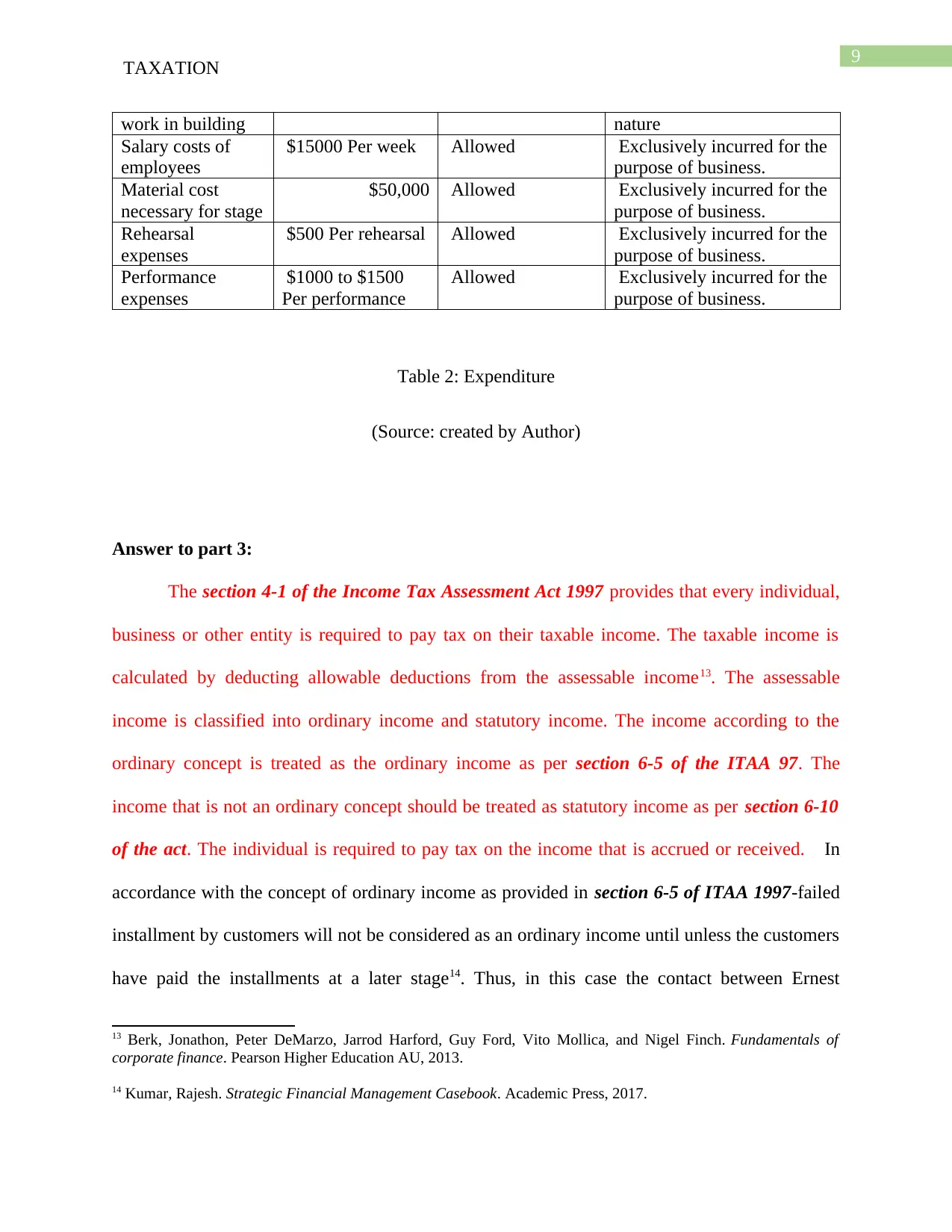
9
TAXATION
work in building nature
Salary costs of
employees
$15000 Per week Allowed Exclusively incurred for the
purpose of business.
Material cost
necessary for stage
$50,000 Allowed Exclusively incurred for the
purpose of business.
Rehearsal
expenses
$500 Per rehearsal Allowed Exclusively incurred for the
purpose of business.
Performance
expenses
$1000 to $1500
Per performance
Allowed Exclusively incurred for the
purpose of business.
Table 2: Expenditure
(Source: created by Author)
Answer to part 3:
The section 4-1 of the Income Tax Assessment Act 1997 provides that every individual,
business or other entity is required to pay tax on their taxable income. The taxable income is
calculated by deducting allowable deductions from the assessable income13. The assessable
income is classified into ordinary income and statutory income. The income according to the
ordinary concept is treated as the ordinary income as per section 6-5 of the ITAA 97. The
income that is not an ordinary concept should be treated as statutory income as per section 6-10
of the act. The individual is required to pay tax on the income that is accrued or received. In
accordance with the concept of ordinary income as provided in section 6-5 of ITAA 1997-failed
installment by customers will not be considered as an ordinary income until unless the customers
have paid the installments at a later stage14. Thus, in this case the contact between Ernest
13 Berk, Jonathon, Peter DeMarzo, Jarrod Harford, Guy Ford, Vito Mollica, and Nigel Finch. Fundamentals of
corporate finance. Pearson Higher Education AU, 2013.
14 Kumar, Rajesh. Strategic Financial Management Casebook. Academic Press, 2017.
TAXATION
work in building nature
Salary costs of
employees
$15000 Per week Allowed Exclusively incurred for the
purpose of business.
Material cost
necessary for stage
$50,000 Allowed Exclusively incurred for the
purpose of business.
Rehearsal
expenses
$500 Per rehearsal Allowed Exclusively incurred for the
purpose of business.
Performance
expenses
$1000 to $1500
Per performance
Allowed Exclusively incurred for the
purpose of business.
Table 2: Expenditure
(Source: created by Author)
Answer to part 3:
The section 4-1 of the Income Tax Assessment Act 1997 provides that every individual,
business or other entity is required to pay tax on their taxable income. The taxable income is
calculated by deducting allowable deductions from the assessable income13. The assessable
income is classified into ordinary income and statutory income. The income according to the
ordinary concept is treated as the ordinary income as per section 6-5 of the ITAA 97. The
income that is not an ordinary concept should be treated as statutory income as per section 6-10
of the act. The individual is required to pay tax on the income that is accrued or received. In
accordance with the concept of ordinary income as provided in section 6-5 of ITAA 1997-failed
installment by customers will not be considered as an ordinary income until unless the customers
have paid the installments at a later stage14. Thus, in this case the contact between Ernest
13 Berk, Jonathon, Peter DeMarzo, Jarrod Harford, Guy Ford, Vito Mollica, and Nigel Finch. Fundamentals of
corporate finance. Pearson Higher Education AU, 2013.
14 Kumar, Rajesh. Strategic Financial Management Casebook. Academic Press, 2017.
⊘ This is a preview!⊘
Do you want full access?
Subscribe today to unlock all pages.

Trusted by 1+ million students worldwide
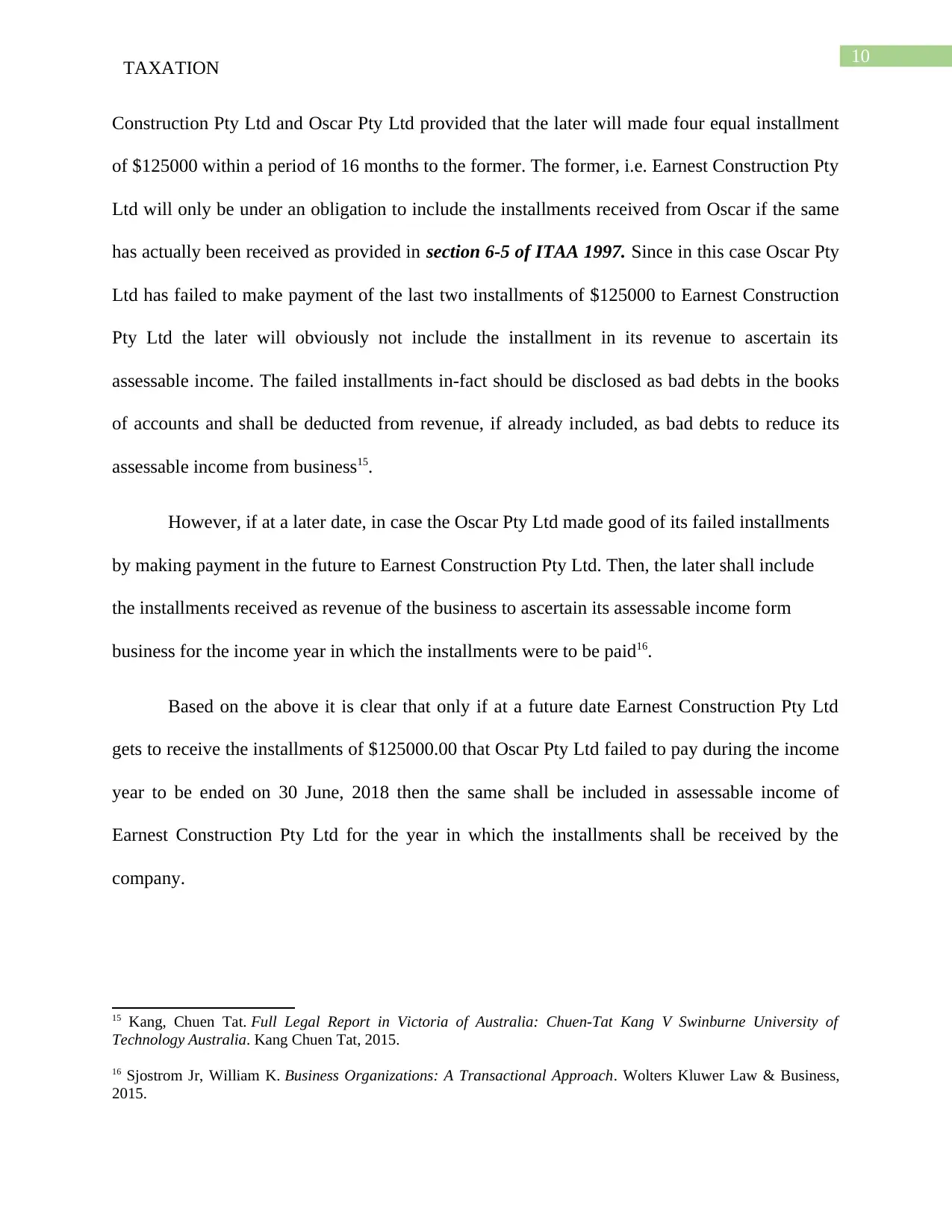
10
TAXATION
Construction Pty Ltd and Oscar Pty Ltd provided that the later will made four equal installment
of $125000 within a period of 16 months to the former. The former, i.e. Earnest Construction Pty
Ltd will only be under an obligation to include the installments received from Oscar if the same
has actually been received as provided in section 6-5 of ITAA 1997. Since in this case Oscar Pty
Ltd has failed to make payment of the last two installments of $125000 to Earnest Construction
Pty Ltd the later will obviously not include the installment in its revenue to ascertain its
assessable income. The failed installments in-fact should be disclosed as bad debts in the books
of accounts and shall be deducted from revenue, if already included, as bad debts to reduce its
assessable income from business15.
However, if at a later date, in case the Oscar Pty Ltd made good of its failed installments
by making payment in the future to Earnest Construction Pty Ltd. Then, the later shall include
the installments received as revenue of the business to ascertain its assessable income form
business for the income year in which the installments were to be paid16.
Based on the above it is clear that only if at a future date Earnest Construction Pty Ltd
gets to receive the installments of $125000.00 that Oscar Pty Ltd failed to pay during the income
year to be ended on 30 June, 2018 then the same shall be included in assessable income of
Earnest Construction Pty Ltd for the year in which the installments shall be received by the
company.
15 Kang, Chuen Tat. Full Legal Report in Victoria of Australia: Chuen-Tat Kang V Swinburne University of
Technology Australia. Kang Chuen Tat, 2015.
16 Sjostrom Jr, William K. Business Organizations: A Transactional Approach. Wolters Kluwer Law & Business,
2015.
TAXATION
Construction Pty Ltd and Oscar Pty Ltd provided that the later will made four equal installment
of $125000 within a period of 16 months to the former. The former, i.e. Earnest Construction Pty
Ltd will only be under an obligation to include the installments received from Oscar if the same
has actually been received as provided in section 6-5 of ITAA 1997. Since in this case Oscar Pty
Ltd has failed to make payment of the last two installments of $125000 to Earnest Construction
Pty Ltd the later will obviously not include the installment in its revenue to ascertain its
assessable income. The failed installments in-fact should be disclosed as bad debts in the books
of accounts and shall be deducted from revenue, if already included, as bad debts to reduce its
assessable income from business15.
However, if at a later date, in case the Oscar Pty Ltd made good of its failed installments
by making payment in the future to Earnest Construction Pty Ltd. Then, the later shall include
the installments received as revenue of the business to ascertain its assessable income form
business for the income year in which the installments were to be paid16.
Based on the above it is clear that only if at a future date Earnest Construction Pty Ltd
gets to receive the installments of $125000.00 that Oscar Pty Ltd failed to pay during the income
year to be ended on 30 June, 2018 then the same shall be included in assessable income of
Earnest Construction Pty Ltd for the year in which the installments shall be received by the
company.
15 Kang, Chuen Tat. Full Legal Report in Victoria of Australia: Chuen-Tat Kang V Swinburne University of
Technology Australia. Kang Chuen Tat, 2015.
16 Sjostrom Jr, William K. Business Organizations: A Transactional Approach. Wolters Kluwer Law & Business,
2015.
Paraphrase This Document
Need a fresh take? Get an instant paraphrase of this document with our AI Paraphraser
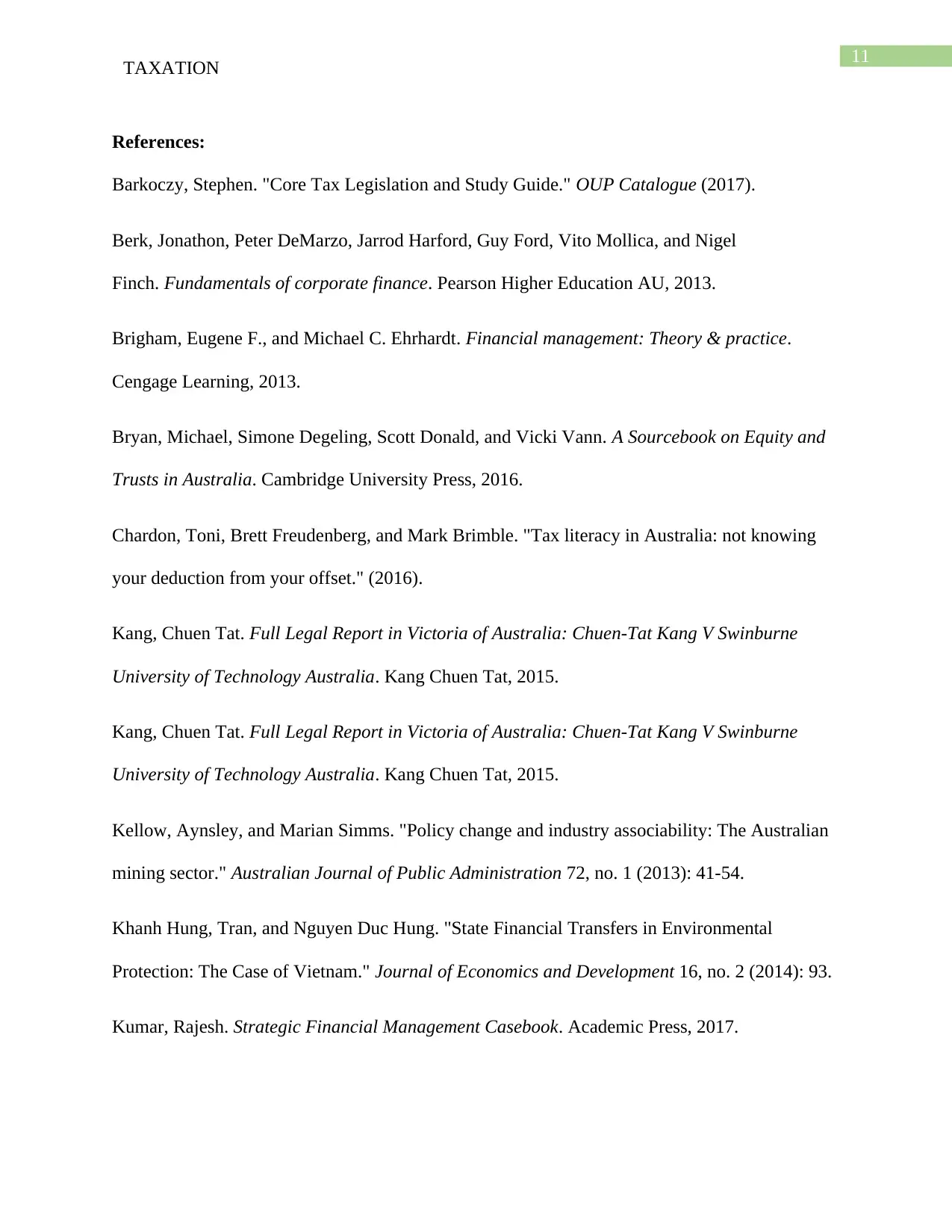
11
TAXATION
References:
Barkoczy, Stephen. "Core Tax Legislation and Study Guide." OUP Catalogue (2017).
Berk, Jonathon, Peter DeMarzo, Jarrod Harford, Guy Ford, Vito Mollica, and Nigel
Finch. Fundamentals of corporate finance. Pearson Higher Education AU, 2013.
Brigham, Eugene F., and Michael C. Ehrhardt. Financial management: Theory & practice.
Cengage Learning, 2013.
Bryan, Michael, Simone Degeling, Scott Donald, and Vicki Vann. A Sourcebook on Equity and
Trusts in Australia. Cambridge University Press, 2016.
Chardon, Toni, Brett Freudenberg, and Mark Brimble. "Tax literacy in Australia: not knowing
your deduction from your offset." (2016).
Kang, Chuen Tat. Full Legal Report in Victoria of Australia: Chuen-Tat Kang V Swinburne
University of Technology Australia. Kang Chuen Tat, 2015.
Kang, Chuen Tat. Full Legal Report in Victoria of Australia: Chuen-Tat Kang V Swinburne
University of Technology Australia. Kang Chuen Tat, 2015.
Kellow, Aynsley, and Marian Simms. "Policy change and industry associability: The Australian
mining sector." Australian Journal of Public Administration 72, no. 1 (2013): 41-54.
Khanh Hung, Tran, and Nguyen Duc Hung. "State Financial Transfers in Environmental
Protection: The Case of Vietnam." Journal of Economics and Development 16, no. 2 (2014): 93.
Kumar, Rajesh. Strategic Financial Management Casebook. Academic Press, 2017.
TAXATION
References:
Barkoczy, Stephen. "Core Tax Legislation and Study Guide." OUP Catalogue (2017).
Berk, Jonathon, Peter DeMarzo, Jarrod Harford, Guy Ford, Vito Mollica, and Nigel
Finch. Fundamentals of corporate finance. Pearson Higher Education AU, 2013.
Brigham, Eugene F., and Michael C. Ehrhardt. Financial management: Theory & practice.
Cengage Learning, 2013.
Bryan, Michael, Simone Degeling, Scott Donald, and Vicki Vann. A Sourcebook on Equity and
Trusts in Australia. Cambridge University Press, 2016.
Chardon, Toni, Brett Freudenberg, and Mark Brimble. "Tax literacy in Australia: not knowing
your deduction from your offset." (2016).
Kang, Chuen Tat. Full Legal Report in Victoria of Australia: Chuen-Tat Kang V Swinburne
University of Technology Australia. Kang Chuen Tat, 2015.
Kang, Chuen Tat. Full Legal Report in Victoria of Australia: Chuen-Tat Kang V Swinburne
University of Technology Australia. Kang Chuen Tat, 2015.
Kellow, Aynsley, and Marian Simms. "Policy change and industry associability: The Australian
mining sector." Australian Journal of Public Administration 72, no. 1 (2013): 41-54.
Khanh Hung, Tran, and Nguyen Duc Hung. "State Financial Transfers in Environmental
Protection: The Case of Vietnam." Journal of Economics and Development 16, no. 2 (2014): 93.
Kumar, Rajesh. Strategic Financial Management Casebook. Academic Press, 2017.
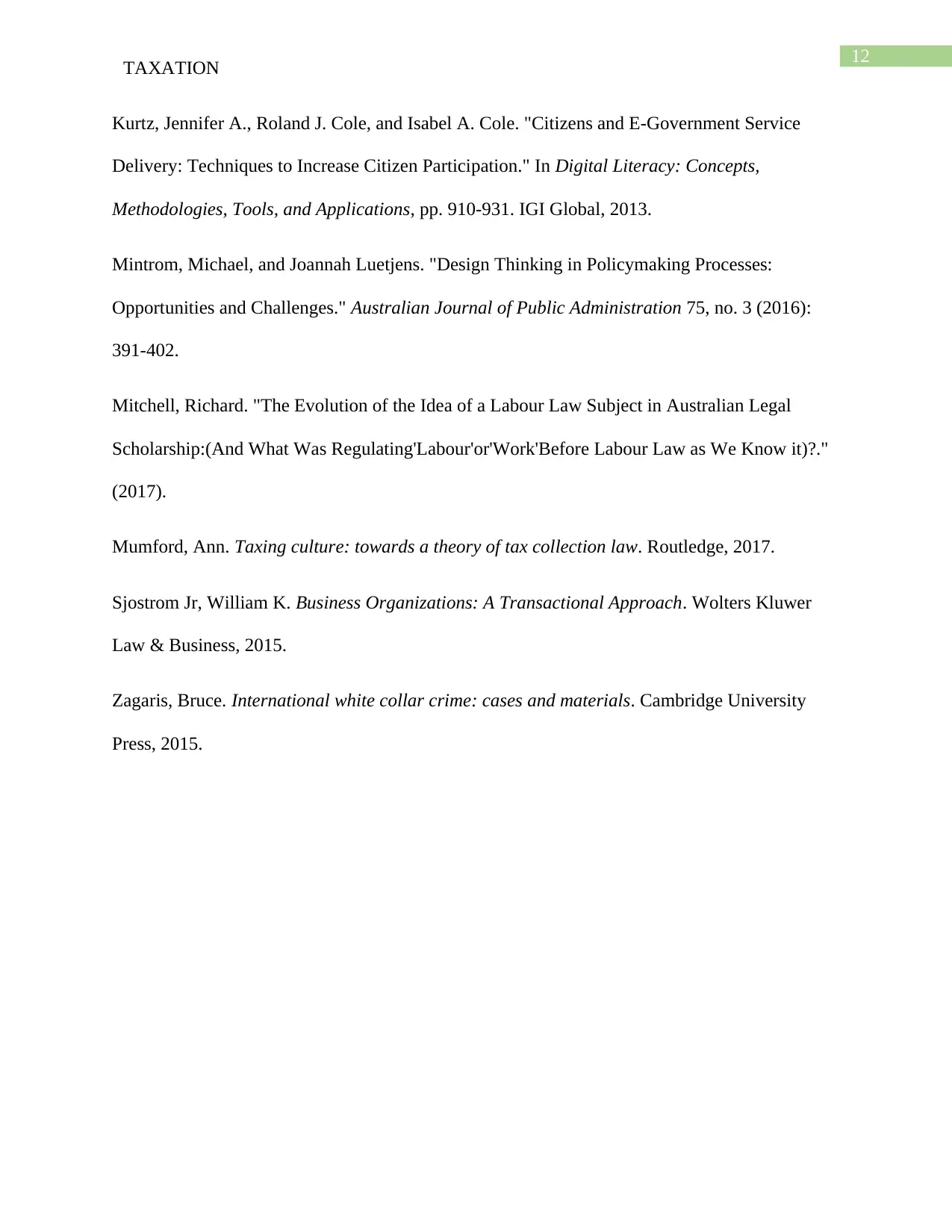
12
TAXATION
Kurtz, Jennifer A., Roland J. Cole, and Isabel A. Cole. "Citizens and E-Government Service
Delivery: Techniques to Increase Citizen Participation." In Digital Literacy: Concepts,
Methodologies, Tools, and Applications, pp. 910-931. IGI Global, 2013.
Mintrom, Michael, and Joannah Luetjens. "Design Thinking in Policymaking Processes:
Opportunities and Challenges." Australian Journal of Public Administration 75, no. 3 (2016):
391-402.
Mitchell, Richard. "The Evolution of the Idea of a Labour Law Subject in Australian Legal
Scholarship:(And What Was Regulating'Labour'or'Work'Before Labour Law as We Know it)?."
(2017).
Mumford, Ann. Taxing culture: towards a theory of tax collection law. Routledge, 2017.
Sjostrom Jr, William K. Business Organizations: A Transactional Approach. Wolters Kluwer
Law & Business, 2015.
Zagaris, Bruce. International white collar crime: cases and materials. Cambridge University
Press, 2015.
TAXATION
Kurtz, Jennifer A., Roland J. Cole, and Isabel A. Cole. "Citizens and E-Government Service
Delivery: Techniques to Increase Citizen Participation." In Digital Literacy: Concepts,
Methodologies, Tools, and Applications, pp. 910-931. IGI Global, 2013.
Mintrom, Michael, and Joannah Luetjens. "Design Thinking in Policymaking Processes:
Opportunities and Challenges." Australian Journal of Public Administration 75, no. 3 (2016):
391-402.
Mitchell, Richard. "The Evolution of the Idea of a Labour Law Subject in Australian Legal
Scholarship:(And What Was Regulating'Labour'or'Work'Before Labour Law as We Know it)?."
(2017).
Mumford, Ann. Taxing culture: towards a theory of tax collection law. Routledge, 2017.
Sjostrom Jr, William K. Business Organizations: A Transactional Approach. Wolters Kluwer
Law & Business, 2015.
Zagaris, Bruce. International white collar crime: cases and materials. Cambridge University
Press, 2015.
⊘ This is a preview!⊘
Do you want full access?
Subscribe today to unlock all pages.

Trusted by 1+ million students worldwide
1 out of 12
Related Documents
Your All-in-One AI-Powered Toolkit for Academic Success.
+13062052269
info@desklib.com
Available 24*7 on WhatsApp / Email
![[object Object]](/_next/static/media/star-bottom.7253800d.svg)
Unlock your academic potential
Copyright © 2020–2025 A2Z Services. All Rights Reserved. Developed and managed by ZUCOL.




